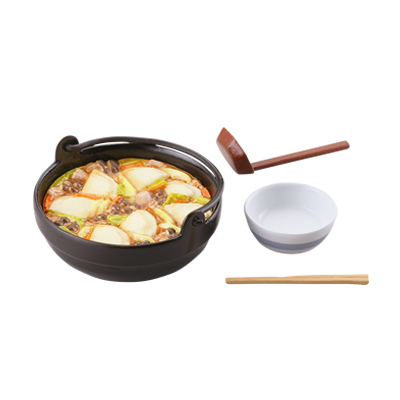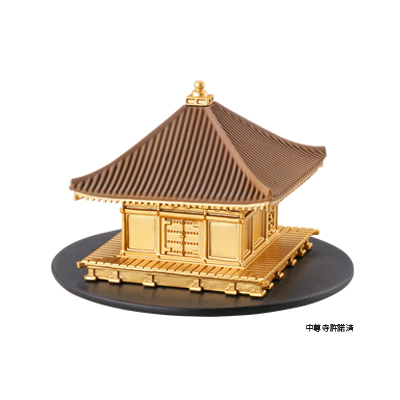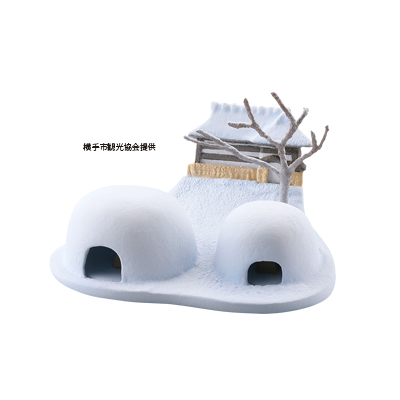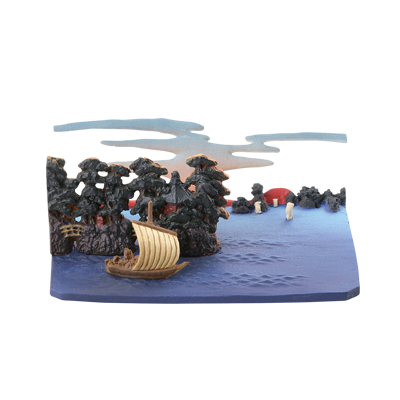-
せんべい汁 / SENBEI-JIRU
青森県八戸市周辺の郷土料理。鶏肉やサバで出汁を取った鍋に汁専用の南部せんべいを割り入れ、野菜や豆腐とともに煮込んで食べる。江戸時代後期の飢(き)饉(きん)や凶作で米不足となった八戸市周辺(南部)では、麦・そばの食文化が発達。そこから小麦粉原料の南部せんべいが生まれ、食べ方のひとつとしてせんべい汁が根付いた。
Senbei-jiru is a local dish from Hachinohe, Aomori, and the surrounding area. It is prepared by boiling vegetables and tofu in a chicken and mackerel broth, sprinkled with broken pieces of nanbu-senbei, a type of cracker. A dietary culture based on wheat and buckwheat has been cultivated in Nanbu, or the Hachinohe area, following a rice famine and crop failure in the late Edo period. Made from wheat flour, nanbu-senbei arose from this food culture. Senbei-jiru is just one recipe that uses it.
-
中尊寺金色堂 / THE KONJIKIDO, CHŪSON-JI TEMPLE
1124年、奥州藤原氏初代清(きよ)衡(ひら)公が上棟した岩手県・中尊寺金色堂。仏教美術の円熟期とされる平安時代末期の工芸技術が集約され、夜光貝の螺(ら)鈿(でん)細工など凝った意匠で極楽浄土が表現されている。須弥(しゅみ)檀(だん)の中心の阿弥陀如来は両脇に観音勢至菩薩、六体の地蔵菩薩、持国天、増長天を従えており、他に例のない仏像構成も特徴。
The Konjikido (Golden Hall) was built under the direction of Kiyohira, first head of the Fujiwara Clan in Oshu, which was completed in 1124. It was constructed within the premises of Chuson-ji Temple in Iwate and is a compilation of craftsmanship at the end of the Heian Period, the mature period of Buddhist art. It expresses the Land of Happiness, with such elaborate designs as raden or iridescent shell inlay based on a great green turban. Amida Nyorai stands at the center of the altar called a shumidan, accompanied by Kannon Bosatsu, Seishi Bosatsu, six statues of Jizo Bosatsu, Jikokuten and Zochoten. The hall is characterized by its unrivaled layout and selection of Buddhist statues.
-
横手のかまくら / YOKOTE KAMAKURA FESTIVAL
横手のかまくらは、雪国秋田ならではの水神様を祀る小正月行事。かまくらの中に子どもたちが入って甘酒などをふるまう。そのメルヘンな世界観はドイツの建築家ブルーノ・タウトが著書で絶賛したほど。開催地である横手市は、商家の街並みが楽しめる増田町(重要伝統的建造物群保存地区)や雪まつり・梵(ぼん)天(でん)でも有名。
Yokote Kamakura in Akita is a shelter made from snow. According to local Yokote tradition, Kamakura aren’t just shelters for people, they are where our local spirits, or kami, dwell. Guests can enjoy amazake, fermented rice drink, in the snow dome called kamakura together with local children. Bruno Taut, a German architect, highly acclaimed the fantastic view in his book. Yokote is also famous for its snow festival Bonden, which is another event at the Yokote Kamakura Festival; and Masuda Town, which is an important preservation district for historic buildings where visitors can see old merchant houses.
-
歌川国芳「日の出之松島」 / HINODE NO MATSUSHIMA
武者、妖怪、猫などを描いて幕末に絶大な人気を博した浮世絵師・歌川国芳が、日本三景・宮城県松島の日の出を描いた作品。松島湾に浮かぶ大小の島々と日の出のコラボレーションを国芳らしいデフォルメで表現している。国芳の風景画ではスカイツリーを予言したとされる「東都三ツ股の図」が有名だが、こちらも隠れた良作。
Kuniyoshi Utagawa was an extremely popular ukiyo-e artist in the last days of the Tokukawa shogunate. His works mainly featured warriors, monsters and cats. This is a landscape of the sunrise at Matsushima, Miyagi, which is one of the three great views of Japan. Kuniyoshi depicts the small and large islands near Matsushima Bay and the rising sun in his unique way. Toto Mitsumata no Zu is his famous work, which is said to have predicted Tokyo Skytree. However, Hinode no Matsushima is his another great work while it is less famous.
-
花笠踊り / THE HANAGASA DANCE
山形県を代表する文化で、威勢のよい「ヤッショ、マカショ!」の掛け声と躍動感が人気の花笠踊り。花笠にあしらわれているのは、山形が一大産地の紅花。発祥は諸説あるが、大正8年に尾花沢市で徳良湖築堤工事が行われ、その際の土突き唄(土台を固める際に唄う)に合わせて笠を廻して即興で踊ったものが原型とされる。
The Hanagasa dance is representative of Yamagata culture, popular for its cheerful call of “yassho, makasho” and vibrant energy. The dance uses a hat called hanagasa that is embellished with safflowers, of which Yamagata is the largest producer. There are many opinions about the origin of the Hanagasa dance. Most plausible is that people started an impromptu dance to Dotsuki-uta (the song sung when a foundation is strengthened) while waving woven hats during embankment work on Lake Tokura in Obanazawa in 1919.
-
赤べこ / AKABEKO
赤く塗った張り子の首振り牛で、福島県・会津の郷土玩具。戦国武将・蒲生氏郷が殖産振興のために招いた技術者から伝わったのが始まりで、平安時代に蔓延した疫病を払った赤い牛が由来とされている。子どもの厄よけのお守りとして重宝されており、ユーモラスな表情とゆらゆらとした首の動きは海外でも人気に。
Akabeko is a cow-shaped, red-painted folk toy from Aizu, Fukushima, which bobs its head. Ujisato Gamou, a military commander during the civil war period, invited engineers to increase production. They brought the toy, which was the beginning of the akabeko figurine. It is said that a red cow drove away the plague that spread during the Heian Period. People use akabeko as a good-luck charm for children. The toy has become popular overseas for its humorous expression and soft, swinging head movements.
-
三陸鉄道 / SANRIKU RAILWAY
岩手県の三陸海岸沿いを走る三陸鉄道。2011年の東日本大震災津波で甚大な被害を受けたが、2014年4月に全線復旧。線路は、津波対策を考え建設されており、被災時は築堤が防潮堤となって住民被害を軽減したことから、現在も同じルートで運行中。そして2019年3月末にJR山田線(釜石~宮古間)の移管を受け、リアス線として運行予定。
Sanriku Railway operates along the Sanriku Coast in Iwate Prefecture. Following the 2011 Great East Japan Earthquake and tsunami that caused substantial damage, operation of all lines resumed in April 2014. The railway was designed and constructed by taking into account the effect of the tsunami and embankments, which acted as a seawall during the earthquake and helped reduce damage to residents. Therefore, Sanriku Railway still operates along the same routes. Operation of the JR Yamada Line (between Kamaishi and Miyako) will be transferred to Sanriku Railway at the end of March 2019, which is planned to become the Riasu Line.
-
みちのくフィギュアみやげ 第3弾 / MICHINOKU FIGURE MIYAGE 3
青森・岩手・秋田・宮城・山形・福島、自然豊かな風土に根ざした生活文化、力強く伝統ある祭や歴史など、さまざまな風景を見せてくれる『みちのく』。それぞれの郷土色豊かな名物を集め、バラエティ豊かな『みちのく』の魅力をお届けします。
“MICHINOKU FIGURE MIYAGE” is the miniature figures of famous institutions in Tohoku region : Aomori, Iwate, Akita, Miyagi, Yamagata and Fukushima.









